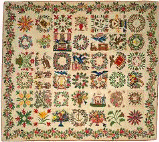Textile Society of America

Textile Society of America: Symposium Proceedings
Date of this Version
2000
Document Type
Article
Citation
In Approaching Textiles, Varying Viewpoints: Proceedings of the Seventh Biennial Symposium of the Textile Society of America, Santa Fe, New Mexico, 2000
Abstract
Two very different types of high status ritual textiles were produced with the use of the discontinuous warp and weft (hereafter DWW) technique during the Wari sojourn on the coast of Peru (ca. 600-800 C.E.): complex tie dyes, in which case the undyed cloth was woven in a DWW -based technique, and cloth woven in mUltiple techniques, wherein DWW is one of several weaves in a single textile.1 In all probability, both types of ritual cloth were created on the coast of Peru for use by the highland Wari culture and/or their coastal representatives.2 In the following paper, I will compare various technical and formal elements of these textiles in pursuit of Wari attitudes to their coastal neighbors. Such analyses add to the ongoing debate about Wari-coastal relations, traditionally based on ceramic distribution and architectural remains.3


Comments
Copyright © 2000 by the author(s).